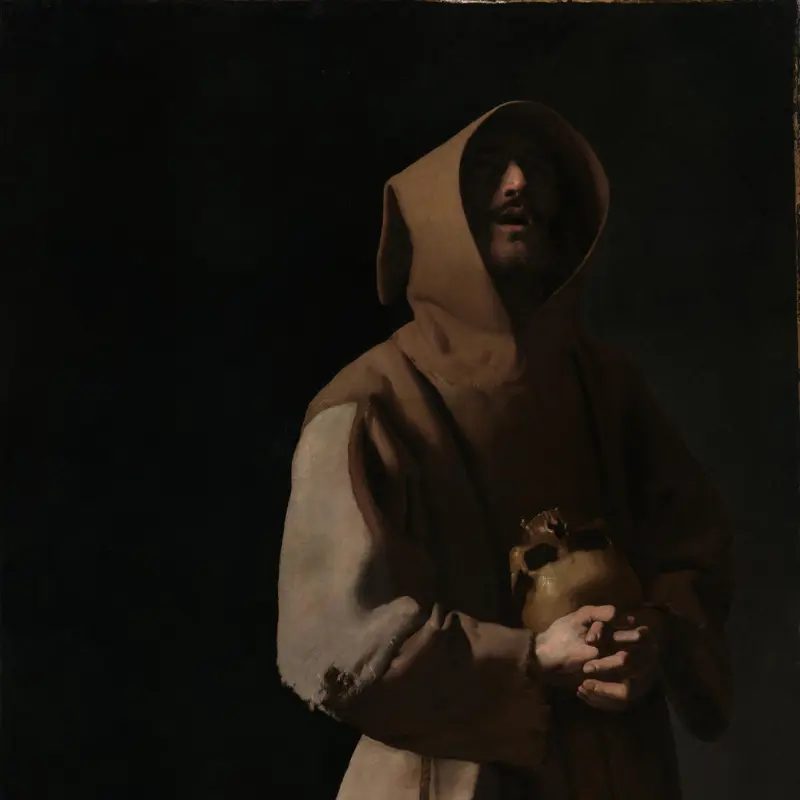Francisco de Zurbarán, 'Saint Francis in Meditation', 1639
About the work
Overview
Saint Francis is shown meditating in a landscape, holding a skull in his hand. His hood is pulled back and the light catches one side of his face, marking out his strong nose and pronounced cheekbone, while the other side remains in deep shadow. He wears the fraying and patched robe of the Franciscans, the religious order he founded in the thirteenth century; all members took a vow of poverty.
The skull symbolises death and refers to the suffering of the crucified Christ – the focus of the saint’s meditation. But this is not a scene of quiet contemplation: Francis’s upward gaze, slightly open mouth and upturned palm suggest he is talking with God. His hands are marked with the stigmata, the wounds of Christ’s crucifixion. In the landscape background you can just make out a simple hut, suggesting that the saint is not in complete isolation.
Key facts
Details
- Full title
- Saint Francis in Meditation
- Artist
- Francisco de Zurbarán
- Artist dates
- 1598 - 1664
- Date made
- 1639
- Medium and support
- oil on canvas
- Dimensions
- 162 × 137 cm
- Inscription summary
- Signed; Dated
- Acquisition credit
- Bequeathed by Major Charles Edmund Wedgwood Wood, 1946
- Inventory number
- NG5655
- Location
- Not on display
- Collection
- Main Collection
Provenance
Additional information
Text extracted from the ‘Provenance’ section of the catalogue entry in Neil MacLaren, revised by Allan Braham, ‘National Gallery Catalogues: The Spanish School’, London 1988; for further information, see the full catalogue entry.
Exhibition history
-
2014Display on Sevillian painting at the Bowes MuseumThe Bowes Museum4 October 2014 - 1 February 2015
-
2015Francisco de Zurbarán. A New PerspectiveMuseo Nacional Thyssen-Bornemisza9 June 2015 - 13 September 2015Museum Kunstpalast10 October 2015 - 31 January 2016
-
2023Saint Francis of AssisiThe National Gallery (London)6 May 2023 - 30 July 2023
Bibliography
-
1862Messrs Churton, Catalogue of Sale… at the Mansion, Aston Hall, on Wednesday 6th August 1862,… the Much Appreciated and Extremely Valuable Gallery of Paintings…finest Productions of the Dutch, Flemish, Spanish, French, Italian, and Other Schools, Now forming the Genuine Collection of the Late Proprietor, at Aston Hall, Chester, 6 August 1862
-
1872Royal Academy of Arts, Exhibition of the Works of the Old Masters (exh. cat. Royal Academy of Arts, 1872), London 1872
-
1952Maclaren, Neil, National Gallery Catalogues: The Spanish School, London 1952
-
1955The National Gallery, The National Gallery: 1938-1954, London 1955
-
1963R.T. Martín, Zurbarán: El pintor gótico del siglo XVII, Seville 1963
-
1965P. Guinard, 'Zurbarán, pintor de paisajes?', Goya, 64-65, 1965, pp. 206-13
-
1970N. MacLaren and A. Braham, The Spanish School, 2nd edn, London 1970
-
1973E. Young, 'An Unknown "St Francis" by Francisco de Zurbarán', The Burlington Magazine, CXV/841, 1973, pp. 245-7
-
1974C. Brown, The Abbé Scaglia Adoring the Virgin and Child by Anthony van Dyck, London 1974
-
1982J.G. von Hohenzollern, Von Greco bis Goya: Vier Jahrhunderte Spanische Malerei (exh. cat. Haus der Kunst, 20 February - 25 April 1982; Künstlerhaus Wien, 14 May - 11 July 1982), Munich 1982
-
1987N.A. Mallory, 'Notas criticas sobre la pintura de Zurbarán', Goya, 1987, pp. 156-61
-
1987J. Baticle, Zurbarán (exh. cat. Metropolitan Museum of Art, 22 September - 13 December 1987; Grand Palais, 14 January - 11 April 1988), New York 1987
-
1988Maclaren, Neil, revised by Allan Braham, National Gallery Catalogues: The Spanish School, 2nd edn (revised), London 1988
-
1989N. Glendinning, 'Nineteenth-Century British Envoys in Spain and the Taste for Spanish Art in England', The Burlington Magazine, CXXXI/1031, 1989, pp. 117-26
-
1994M.L. Caturla and O. Delenda, Francisco de Zurbarán, Paris 1994
-
2001
C. Baker and T. Henry, The National Gallery: Complete Illustrated Catalogue, London 2001
About this record
If you know more about this work or have spotted an error, please contact us. Please note that exhibition histories are listed from 2009 onwards. Bibliographies may not be complete; more comprehensive information is available in the National Gallery Library.



